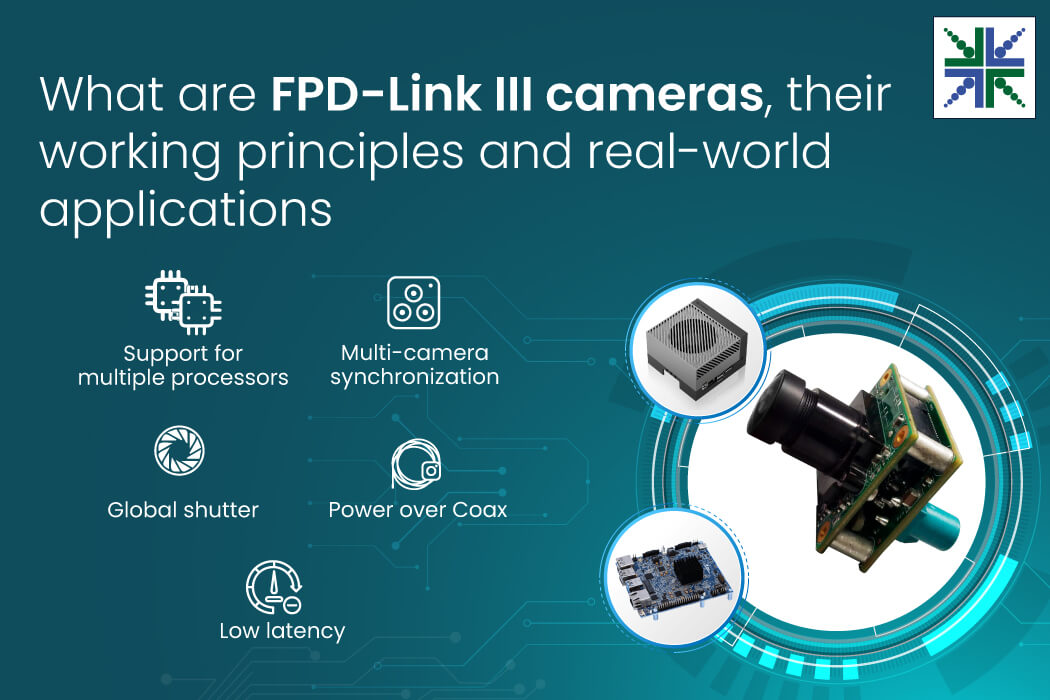The demand for high-performance vision systems continues to grow across industries that rely on consistent data transmission from camera sensors to processing units. FPD-Link III cameras have emerged as a strong choice in embedded vision due to their ability to deliver high-speed data, long-range connectivity, and synchronized control—all over a single cable.
The FPD-Link III interface was developed to address the limitations of traditional camera transmission methods, especially in environments where bandwidth, distance, and signal integrity matter. With embedded applications becoming more dependent on low-latency, high-resolution imaging, this technology is increasingly finding its place across several use cases.
In this blog, you’ll get expert insights on how these cameras work, their key features, as well as popular applications.
What Are FPD-Link III Cameras?
FPD-Link III cameras use a high-speed serial interface that enables transmission of video, power, and control data through a single coaxial or twisted pair cable. They support long-distance signal transmission while maintaining low latency and high bandwidth. The protocol is an enhancement over earlier versions (FPD-Link and FPD-Link II), offering bidirectional communication and reducing the overall system complexity.
The architecture of FPD-Link III cameras supports the image data channel and a control feedback path. It enables synchronized multi-camera setups and seamless communication with the image processor. So, these cameras are ideal for applications that involve edge AI platforms, real-time inference, and machine learning.
How Do FPD-Link III Cameras Work?
The working principle of FPD-Link III cameras is based on the serialized transmission of parallel data. The camera sensor captures image data, which is serialized and transmitted through a deserializer-serializer (SerDes) architecture. A serializer, placed close to the sensor, converts the parallel data into a high-speed serial stream. This stream travels through the cable to the deserializer located near the host processor.
The deserializer converts the serial data back into parallel form and forwards it to the processing unit, such as a GPU or an edge AI module. Simultaneously, the deserializer sends control data back to the serializer through a return channel in the same cable, enabling commands like exposure adjustment, frame synchronization, and sensor configuration.
This minimizes the number of connectors, supports robust EMI/EMC performance, and drives flexible mechanical integration in complex systems.
Top Features of FPD-Link III Cameras
Compatibility with edge AI platforms
FPD-Link III cameras are compatible with leading AI inference systems, including Texas Instruments SK-TDA4VM, NVIDIA Jetson AGX Orin, and AGX Xavier. It makes them perfect for edge-based applications that demand onboard processing without cloud dependence. These platforms benefit from high-bandwidth image data that these cameras deliver with minimal frame delay.
Bidirectional control channel (with low-cost cable)
Whether using a twisted pair or coaxial cable, both power and control signals are transmitted without separate wiring. It means that FPD-Link III cameras reduce cable bulk and improve flexibility in product design. Their control channel enables real-time adjustments to imaging parameters, frame sync triggers, and temperature or status monitoring.
Low latency in long-distance applications
The FPD-Link III architecture delivers stable transmission across several meters, maintaining low latency throughout. This is important in time-sensitive applications that need real-time visual feedback to support navigation and object detection. Low latency also plays a role in use cases where immediate response is a major concern.
Multi-camera synchronization
Multi-camera systems require accurate alignment in timing for accurate image stitching, depth estimation, or 360-degree awareness. FPD-Link III cameras enable synchronized triggering of multiple camera modules, helping manage complex workflows such as stereo vision, volumetric scanning, or wide-area monitoring. Moreover, the clock synchronization feature helps all connected cameras capture frames simultaneously.
EMI/EMC performance
In industrial and automotive settings, exposure to electromagnetic interference is common. FPD-Link III cameras support transmission protocols that suppress noise and maintain signal clarity across noisy environments. Shielded coaxial cables and differential signaling techniques contribute to this resilience, which helps maintain data accuracy near motors, wireless modules, or high-voltage lines.
Virtual channel support
FPD-Link III cameras offer video streams alongside embedded metadata using virtual channel support. It allows parallel delivery of multiple data types over the same link. That way, metadata like timestamps, sensor status, or motion vectors can travel with the image feed without separate paths. As a result, downstream processing is simplified at the host end.
Use Cases of FPD-Link III Cameras
Autonomous Mobile Robots (AMRs)
AMRs use vision systems for navigation, obstacle detection, and item handling in markets such as logistics, healthcare, and retail. FPD-Link III cameras provide real-time image feeds to edge processors onboard the robot for making split-second navigation decisions. Furthermore, the long-distance support helps with mounting the camera at various points while keeping the processor centrally located.

Agricultural vehicles
Automated tractors and harvesters depend on high-speed vision for tasks like crop detection, soil analysis, and machinery alignment. FPD-Link III cameras meet the demands of outdoor operations for strong EMI shielding and consistent frame capture even under vibration. Synchronization across multiple cameras also helps in wide-area monitoring and coverage.
Self-checkout systems
Retail checkout systems leverage cameras to monitor item placement, detect errors, and track customer movement. They must have low-latency image capture capabilities, along with seamless integration with AI modules to identify items and verify transactions. The compact design and minimal cabling of FPD-Link III cameras make them easy to integrate into kiosk-based solutions.
Surveillance systems
Security systems operating in expansive spaces such as airports, malls, or industrial parks demand high-resolution imaging with low noise. FPD-Link III cameras come with long cable lengths without signal degradation, making it easy for ceiling-mounted or pole-mounted installations. Multi-camera synchronization also helps with wide-angle setups without timing discrepancies.
Parking lot systems
In automated parking setups, vision systems help perform crucial tasks like license plate recognition, occupancy detection, and gate control. FPD-Link III supports full-HD or 4K camera modules that transmit high-quality footage to processors for real-time detection. The low latency and synchronized capture help monitor multiple entry and exit points simultaneously.
e-con Systems Offers High-Performance FPD-Link III Cameras
Since 2003, e-con Systems® has been designing, developing, and manufacturing OEM cameras. We offer a series of FPD-Link III cameras built for seamless integration with popular edge AI platforms. Our cameras support HD video transmission and bidirectional control over a single coaxial or twisted pair cable and come with support for up to 15m cable length.
Go to our Camera Selector Page to view our end-to-end portfolio.
If you require expert help to find the right FPD-Link III camera for your embedded vision system, please write to camerasolutions@e-consystems.com.

Prabu is the Chief Technology Officer and Head of Camera Products at e-con Systems, and comes with a rich experience of more than 15 years in the embedded vision space. He brings to the table a deep knowledge in USB cameras, embedded vision cameras, vision algorithms and FPGAs. He has built 50+ camera solutions spanning various domains such as medical, industrial, agriculture, retail, biometrics, and more. He also comes with expertise in device driver development and BSP development. Currently, Prabu’s focus is to build smart camera solutions that power new age AI based applications.





